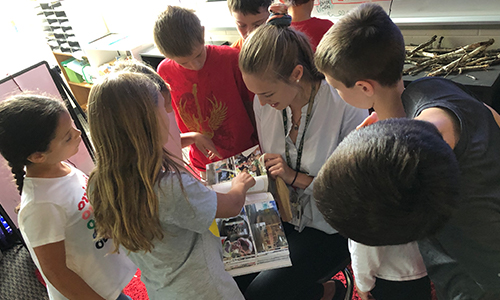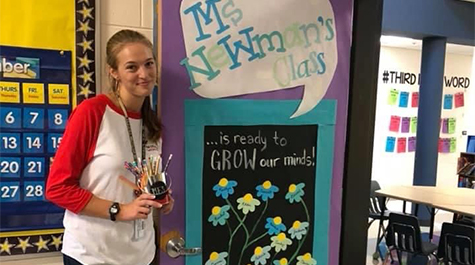Alumna engages students, teachers and the community through multicultural advocacy
Emma Zahren-Newman ’17, M.A.Ed. ’18 watched her seven and eight-year-old students calmly color in art class when she saw a police car slowly roll up the street. The police are here to protect us, she said to herself. It was a hot summer day and the lights were off to cool the classroom. It's dark in here, the police officer can't even see them, she thought. In motions just as relaxed as they had been when coloring, several students stood up, faced the window, and raised their hands. Are they playing around?
After a moment, she recognized the gesture. She had seen it before at protests and on the news, but this time it was in her classroom and the students were not protesting, they were protecting themselves.
It wasn’t until she saw her students raise their hands in response to the real danger they felt that she realized that she had never been scared of a police officer looking through that window and seeing her skin color.
Emma remembers this as the moment where she was awakened to her white privilege.
Emma is the oldest of nine siblings and her upbringing in blended, Spanish-speaking households conditioned her to the realities of students like her brothers and sisters who rarely read stories with main characters that reflected their Latin roots or learned about historical figures that looked like them. In the art classroom on that summer day, she realized that her identity guided her inner thoughts in a way that failed to acknowledge the identities of the students in her classroom who did not look the same as her. There was privilege in looking through the window as a white female, but her African American students saw a different world when they looked through that same glass.
Her awakening made her especially drawn to working with students from different cultural and racial backgrounds. After she began her master’s program in elementary education and bilingual education at William & Mary a little while later, Emma learned about the importance of understanding the cultural and familial background of each child. In Professor Katherine Barko-Alva’s classes, she learned about how all aspects of a student’s identity translate into the classroom and how to teach students in a culturally sensitive way that builds upon students’ strengths.
 Her experience encouraged her to become a multicultural engagement advocate at Matoaka Elementary School in Williamsburg, where she now teaches third grade.
Her experience encouraged her to become a multicultural engagement advocate at Matoaka Elementary School in Williamsburg, where she now teaches third grade.
“As a teacher, we are all agents of social justice, and it is important that we never forget the important role we play in society and in history,” she says.
Being an educator makes her aware of the power she has in shaping young students’ attitudes toward race and the underlying messages that can affect student’s beliefs without them even realizing it. By teaching students the social and political structures that make it more difficult for people who are racially diverse to succeed, she challenges one particular notion: people who work hard are rewarded.
“Without speaking truth to economic and social disparities, we allow for racist thoughts to take root in our children’s brains.”
She speaks truth to such disparities by teaching the historical context of centuries past that results in African American students raising their hands in school at the mercy of police officers today.
 The work of being a multicultural advocate calls her to engage the entire school, colleagues and students alike, in increasing its racial literacy, creating trivia games and reading challenges for students to interact with history in a new way, and engaging in social media outreach to involve the community. For many students, it may be one of the few times they are able to learn about historical figures they may have never heard of before, celebrate people who look like them, and have new role models they can identify with.
The work of being a multicultural advocate calls her to engage the entire school, colleagues and students alike, in increasing its racial literacy, creating trivia games and reading challenges for students to interact with history in a new way, and engaging in social media outreach to involve the community. For many students, it may be one of the few times they are able to learn about historical figures they may have never heard of before, celebrate people who look like them, and have new role models they can identify with.
“One thing that I love about working with multicultural engagement advocates from each school, is that we are constantly assessing ourselves and our schools to find ways to counteract the legacy of institutionalized racism. We are constantly striving to be better for our students of all cultural backgrounds.”
Since the day that she saw her students stand against the classroom window in fear, she has often thought about them and questioned her role as a teacher in protecting students. She is guided by that memory to address race in the classroom in a safe way by providing the historical context that led to its creation as a social construct.
“Being a social justice ally is a lot of work, but not being an ally as a teacher is just not an option,” she says. “I love my profession because I have never met a teacher who is not up for the task. Teachers are guided by compassion to help their students grow as learners, people, and citizens. If there is anyone who is the most equipped to stand toe-to-toe with institutionalized racism, it's teachers.”
